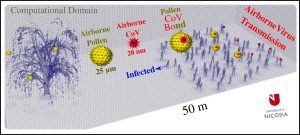Computer model recreates a willow tree and nearby crowd to provide new perspective on social distancing measures.
From the Journal: Physics of Fluids
WASHINGTON, June 22, 2021 — Most models explaining how viruses are transmitted focus on viral particles escaping one person to infect a nearby person. A study on the role of microscopic particles in how viruses are transmitted suggests pollen is nothing to sneeze at.
In Physics of Fluids, by AIP Publishing, Talib Dbouk and Dimitris Drikakis investigate how pollen facilitates the spread of an RNA virus like the COVID-19 virus. The study draws on cutting-edge computational approaches for analyzing fluid dynamics to mimic the pollen movement from a willow tree, a prototypical pollen emitter. Airborne pollen grains contribute to the spread of airborne viruses, especially in crowded environments.

“To our knowledge, this is the first time we show through modeling and simulation how airborne pollen micrograins are transported in a light breeze, contributing to airborne virus transmission in crowds outdoors,” Drikakis said.
The researchers noticed a correlation between COVID-19 infection rates and the pollen concentration on the National Allergy Map. Each pollen grain can carry hundreds of virus particles at a time. Trees alone can put 1,500 grains per cubic meter into the air on heavy days.
The researchers set to work by creating all the pollen-producing parts of their computational willow tree. They simulated outdoor gatherings of roughly 10 or 100 people, some of them shedding COVID-19 particles, and subjected the people to 10,000 pollen grains.
“One of the significant challenges is the re-creation of an utterly realistic environment of a mature willow tree,” said Dbouk. “This included thousands of tree leaves and pollen grain particles, hundreds of stems and a realistic gathering of a crowd of about 100 individuals at about 20 meters from the tree.”
Tuning the model to the temperature, windspeed, and humidity of a typical spring day in the U.S., the pollen passed through the crowd in less than one minute, which could significantly affect the virus load carried along and increase the risk of infection.
The authors said the 6-foot distance often cited for COVID-19 recommendations might not be adequate for those at risk for the disease in crowded areas with high pollen. New recommendations based on local pollen levels could be used to manage the infection risk better.
While calling attention to other forms of COVID-19 transmission, the authors hope their study stokes further interest in the fluid dynamics of plants.
Next, they look to better understand the mechanisms underlying the interaction between airborne pollen grains and the human respiratory system under different environmental conditions.
The article, “On pollen and airborne virus transmission,” is authored by Talib Dbouk and Dimitris Drikakis. The article will appear in Physics of Fluids on June 22, 2020 (DOI: 10.1063/5.0055845). After that date, it can be accessed at https://aip.scitation.org/doi/10.1063/5.0055845.
For more information:
Larry Frum
media@aip.org
301-209-3090
Article Title
On pollen and airborne virus transmission
Authors
Talib Dbouk, Dimitris Drikakis
Author Affiliations
University of Nicosia
